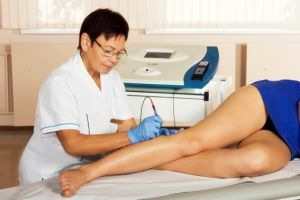 Phlebology is a specific branch of vascular surgery, focused on problems with veins.
Phlebology is a specific branch of vascular surgery, focused on problems with veins.
Recently, this direction not only shows good results, but also actively develops, as the problem of veins has become even more urgent, and patient requests are higher. And this is understandable, especially if it concerns the beautiful half of humanity.
Operative intervention should create a minimum of discomfort, maximum effect, plus, the absence of all kinds of stitches and scars.
In order to receive worthy treatment, it is necessary to contact a specialist-phlebologist who will diagnose the diagnosis as accurately as possible and prescribe the most appropriate treatment, proceeding from the individual characteristics of each patient.
The phlebologist is a specialist whose main activity is connected with venous pathologies of the lower extremities. Often this role is performed by an ordinary or vascular surgeon. In principle, the most important thing is the experience and methods of work that the doctor uses. Does it belong to the old school and continues to solve the problems by surgical intervention, or does it use modern methods and minimally invasive methods of combating varicose veins.
The main task of a phlebologist is to make an accurate diagnosis by examination and additional tests and studies, with the appointment of treatment appropriate to this particular case, further rehabilitation and prevention of varicose development in the future.
Contents of
- What diseases are treated by phlebologist
- Who needs assistance from specialist
- Preliminary examination and diagnosis
- The first stage of
- The second stage of
- The third stage of
- The fourth stage of
- What can the specialist
- help? Easy cases of
- The second stage of
- The started cases of
- How to find a good specialist
- , - Yes?!
What diseases the phlebologist
treats A phlebologist is a specialist who eliminates a variety of venous pathologies developing on the lower and upper limbs. By selecting the therapy techniques, the vascular surgeon phlebologist will help get rid of:
- varicose veins;

- trophic ulcer;
- of reticular varicose veins;
- thrombophlebitis;
- postthrombotic manifestations;
- of telangiectasia;
- of venous dysplasia;
- of varicose veins bleeding;
- venous insufficiency.
Treatment will be more effective if you turn to a specialist at the beginning of the disease, when the first signs appear. If the patient starts the case for the sake, the treatment will take not only a lot of time and money, it's good if it does without consequences.
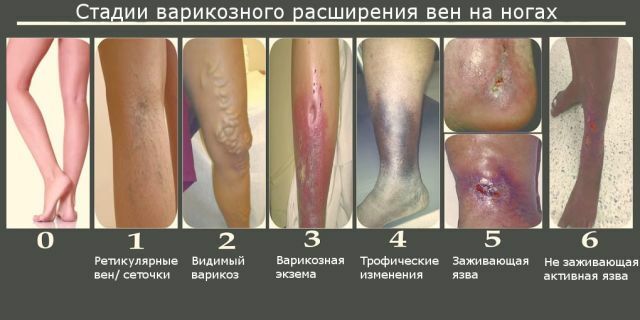
Who needs the help of a specialist
At the first sign of venous disease, you should always seek help from a specialist. As a result of excessive physical exertion, passive lifestyle, overweight, pregnancy, old age, the propensity of the body, various diseases of the veins, knitted with a violation of the mechanism of blood flow, can develop.
Should be more attentive to yourself and, after noticing at least some of the manifestations, do not delay the trip to the phlebologist:
- nocturnal cramps;

- sensation of warmth in the muscles of the legs, arising suddenly;
- severity in the lower limbs;
- swelling of the feet;
- , when viewed, a person can detect bulging veins;
- pain along the entire surface of the legs;
- nodules and seals, which are located on veins, which can be examined or palpated.
Preliminary examination and diagnosis
Primary consultation of a phlebologist occurs in several stages.
First stage
Oral examination by the doctor. The patient, who first addressed the problem of veins, should describe to the phlebologist his complaints, suspicions, symptoms.
These data already allow the doctor to narrow down the range of problems and then only specify which disease the person has.
The second stage of
 In the second stage, the doctor directly performs an examination( it can be done and called a specialist at home).Phlebologist examines the patient, paying special attention to the upper and lower limbs.
In the second stage, the doctor directly performs an examination( it can be done and called a specialist at home).Phlebologist examines the patient, paying special attention to the upper and lower limbs.
Of particular interest are various seals, swelling, discoloration of the skin, its elasticity. The inspection is carried out in a lying and standing position. Then follows the study of the beating of the radial arteries.
The third stage of the
This is followed by more complex studies of deep veins. For this stage, the purpose of various samples is typical, which will give a complete picture of the disease:
- Delbe-Partes test : a patient is banded into the thighs and suggested for some time to be like. After this, the
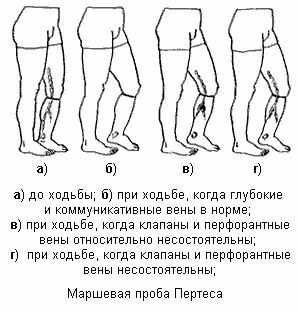 will see a redistribution of blood from the upper to the deep veins, indicating a problem.
will see a redistribution of blood from the upper to the deep veins, indicating a problem. - Sheinis test : with the help of a tourniquet, the upper and middle part of the thigh, and also under the knee, are pulled. The man climbs to his feet. If the doctor notices the rapid filling of overtrained vessels, then pathology is present in the valves.
- The Trojan-Trendelenburg Trial will also help to determine the presence of a valve pathology: the overstretched leg should be lifted upwards, and after becoming on it. If the blood quickly fills the vein near the limb, the problem takes place.
- Prett test( two-screw) : for this sample, the patient's legs are rewound with elastic bandages. So it is necessary to pass about half an hour. If the pain is present, there are problems with deep veins. In case the symptoms are gone, there is no pathology of the veins.
Fourth stage
After the initial examination, the doctor proceeds to an in-depth study of the problem and can prescribe a lot of research:
- dopplerography is an ultrasound technique that provides insight into the nature of the problem and its features and severity in the smallest details. Helps to detect the presence of thrombi;
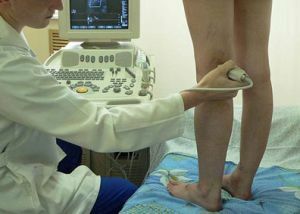
- hemostasiogram - blood test, which determines the parameters of its coagulation;
- Ultrasound of the extremities ( lower) will help to determine the general condition of the veins, their walls, the viability of the venous system;
- tests for thrombophlebitis will help to determine the presence of thrombi and predisposition to their appearance;
- computed tomography makes it possible to examine the state of vessels in any part of the body;
- polarography allows you to observe the oxygen tension in the tissues, which in turn is an indicator of the varying degree of microcirculatory disturbance in venous insufficiency;
- electrocardiogram ;
- Ultrasound of other organs of .
How can a specialist
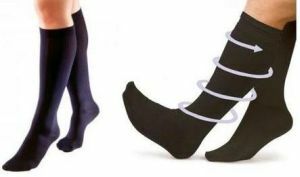 help? A phlebology doctor conducts diagnostics and prescribes correct treatment for a specific patient case.
help? A phlebology doctor conducts diagnostics and prescribes correct treatment for a specific patient case.
According to the results of tests in mild cases, a specialist can prescribe a compression knitwear( especially for pregnant women and during the recovery after delivery).Depending on the severity of the disease, the appropriate treatment will be used.
Mild cases of
The initial( cosmetic) stage of varicose veins is treated by microsclerotherapy. In accordance with this method, the venous sprocket is removed by inserting a special sclerosing agent into the vessel through a very thin needle.
Laser coagulation is used - laser removal of small vessels. Microthermocoagulation - removal of asterisks with the aid of apparatus "Surgitron".
Second stage
The next stage is characterized by the destruction of the valves of the superficial veins. 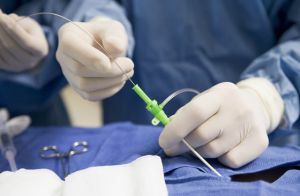
To resolve this issue, a physician can designate:
- operative intervention under general anesthesia and subsequent rehabilitation in a hospital;
- radiofrequency obliteration;
- laser coagulation with miniflebectomy.
Running cases of
At this stage, trophic ulcers of varying depth and diameter develop. Methods of therapy aimed at their healing, the removal of venous inflammation are applied. After this, phlebologists resort to surgical intervention( as in the second stage).
How to find a good specialist
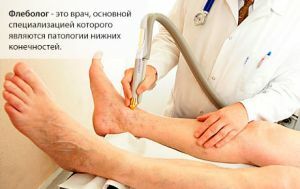 Often, people turn to the doctor not immediately after the onset of symptoms, but after some time, when manifestations bring enough discomfort.
Often, people turn to the doctor not immediately after the onset of symptoms, but after some time, when manifestations bring enough discomfort.
It's not easy to get a good doctor and get rid of a disease, because the patient hurries to get to someone. And this is fundamentally the wrong approach to choosing a specialist and your health.
So, in order to choose a good specialist it is worthwhile:
- to give a preference for the one whose services were used by the familiar ones and were well received by ;
- use the Internet : in the choice of the clinic, focus on the narrowly-managed medical institutions with the corresponding state standards of licenses;
- physician should be recognized in his circles , have membership in relevant European, Russian societies;
- phlebologist in a large state clinic with solid experience of and a large number of operations performed is an ideal option;
- professional necessarily finds an individual approach to each customer and leaves its contact details.
Popular, - yes? !
Opinion of women who have already used the services of phlebologist.
I addressed to different specialists with varicose veins, which tormented me for several years. All as one insisted on surgical intervention. And, finally, I went to a private clinic where I was not only assigned a strictly selected individual treatment, but I saw the results very soon.
Inna, 35 years old
I have a sedentary work, therefore, it began to observe the manifestations of varicose early. Only thanks to a good doctor could I avoid surgery and cure my veins. Also, the preventive maintenance prescribed to me by a phlebologist plays an important role.
Oksana, 40 years old
Phlebologist is a specialist who will help not only cure blood vessels, but also prescribe high-quality preventive maintenance, eliminating the recurrence of the disease.
The most important condition for healthy legs and veins is active lifestyles, healthy eating, full sleep and, in case of symptoms, an urgent visit to a specialist in a medical institution.
